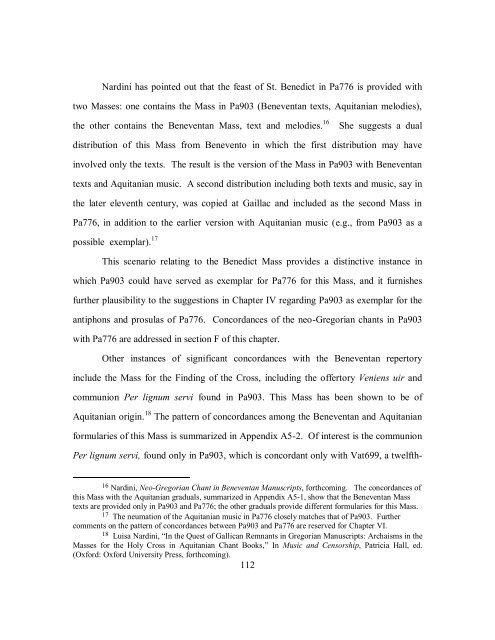Front Matter Template - The University of Texas at Austin
Front Matter Template - The University of Texas at Austin
Front Matter Template - The University of Texas at Austin
Create successful ePaper yourself
Turn your PDF publications into a flip-book with our unique Google optimized e-Paper software.
Nardini has pointed out th<strong>at</strong> the feast <strong>of</strong> St. Benedict in Pa776 is provided with<br />
two Masses: one contains the Mass in Pa903 (Beneventan texts, Aquitanian melodies),<br />
the other contains the Beneventan Mass, text and melodies. 16 She suggests a dual<br />
distribution <strong>of</strong> this Mass from Benevento in which the first distribution may have<br />
involved only the texts. <strong>The</strong> result is the version <strong>of</strong> the Mass in Pa903 with Beneventan<br />
texts and Aquitanian music. A second distribution including both texts and music, say in<br />
the l<strong>at</strong>er eleventh century, was copied <strong>at</strong> Gaillac and included as the second Mass in<br />
Pa776, in addition to the earlier version with Aquitanian music (e.g., from Pa903 as a<br />
possible exemplar). 17<br />
This scenario rel<strong>at</strong>ing to the Benedict Mass provides a distinctive instance in<br />
which Pa903 could have served as exemplar for Pa776 for this Mass, and it furnishes<br />
further plausibility to the suggestions in Chapter IV regarding Pa903 as exemplar for the<br />
antiphons and prosulas <strong>of</strong> Pa776. Concordances <strong>of</strong> the neo-Gregorian chants in Pa903<br />
with Pa776 are addressed in section F <strong>of</strong> this chapter.<br />
Other instances <strong>of</strong> significant concordances with the Beneventan repertory<br />
include the Mass for the Finding <strong>of</strong> the Cross, including the <strong>of</strong>fertory Veniens uir and<br />
communion Per lignum servi found in Pa903. This Mass has been shown to be <strong>of</strong><br />
Aquitanian origin. 18 <strong>The</strong> p<strong>at</strong>tern <strong>of</strong> concordances among the Beneventan and Aquitanian<br />
formularies <strong>of</strong> this Mass is summarized in Appendix A5-2. Of interest is the communion<br />
Per lignum servi, found only in Pa903, which is concordant only with V<strong>at</strong>699, a twelfth-<br />
16 Nardini, Neo-Gregorian Chant in Beneventan Manuscripts, forthcoming. <strong>The</strong> concordances <strong>of</strong><br />
this Mass with the Aquitanian graduals, summarized in Appendix A5-1, show th<strong>at</strong> the Beneventan Mass<br />
texts are provided only in Pa903 and Pa776; the other graduals provide different formularies for this Mass.<br />
17 <strong>The</strong> neum<strong>at</strong>ion <strong>of</strong> the Aquitanian music in Pa776 closely m<strong>at</strong>ches th<strong>at</strong> <strong>of</strong> Pa903. Further<br />
comments on the p<strong>at</strong>tern <strong>of</strong> concordances between Pa903 and Pa776 are reserved for Chapter VI.<br />
18 Luisa Nardini, “In the Quest <strong>of</strong> Gallican Remnants in Gregorian Manuscripts: Archaisms in the<br />
Masses for the Holy Cross in Aquitanian Chant Books,” In Music and Censorship, P<strong>at</strong>ricia Hall, ed.<br />
(Oxford: Oxford <strong>University</strong> Press, forthcoming).<br />
112

















